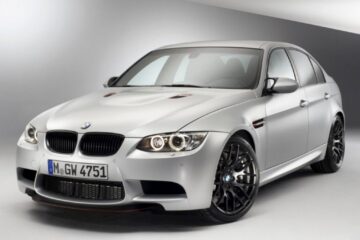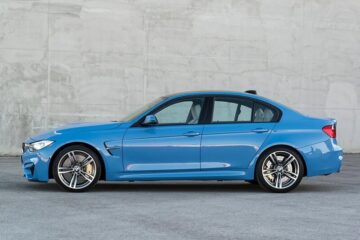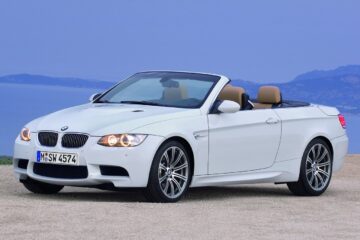The legendary BMW M3 E30 sport model first saw the light of day in 1985 at the Frankfurt Motor Show, held in the fall (September). The first generation was offered to buyers exclusively in the coupe body version. Only in 1988, the Bavarians began to offer a convertible version.
Appearance
The choice of buyers who put their eyes on the car, offered two body options – convertible and BMW E30 M3 coupe. External differences from the standard three were quite noticeable: the wheel arches were wider, disks were installed with a larger diameter, and there was a dodger. The design of the side mirrors was also changed. In addition, many other details were changed.
When comparing the BMW M3 E30 sports car and the regular version of the BMW 3 Series, you can see that the proportions are very different. The sporty modification has become lower and wider. By and large, these cars do not have a single common body panel.
Considering the years of production of the first generation M3 E30, almost all cars were not very tall, but today there is a large number of tall cars on the roads. This creates certain problems for the owners of the legend in the modern world – oncoming cars are strongly blinded by headlights.
The exterior of the Bavarian car is quite aggressive. This look was obtained thanks to a unique combination of a front bumper with a low overhang, aggressive aerodynamic dodger, rear spoiler, as well as a rather large twin exhaust pipe, which laconically fits into the sporty image of the car. The M3 E30 dodger immediately catches the eye when looking at the car.
Thanks to the impressive expansion of the wheel arches, engineers managed to “stick” R16 wheels mounted on alloy wheels. This also gives the car a rather peculiar appearance and distinguishes it from the general flow of usual serial models. One can say one thing – designers have tried their best, and engineers managed to realize everything conceived.
Interior
The interior of the car has received rather respectable outlines, but at the same time it was possible to keep sporty notes, characteristic for the general concept of BMB M-series. The driver immediately catches the eye with a three-spoke steering wheel, as well as an analog speedometer, marked to 260 kilometers per hour. The center console, turned towards the driver, also stands out against the general background of the interior.
The tunnel separating the driver’s and passenger’s seat also houses certain components for controlling the vehicle. Next to the parking brake lever there is a unit that allows controlling the degree of suspension rigidity. This feature is present only on models manufactured after 1988, because it was to them that the EDC (electronic shock absorber stiffness control) option was added. There are three operating modes on the regulator: K, N and S, which are responsible for comfort, normal and sport modes, respectively.
Designers managed to achieve perfect ergonomics of the interior space of the sporty modification of the car. But this cannot be said about the quality of assembly, as the panels, which in some places are fitted with different gaps and irregularities, immediately catch the eye.
A notable fact is the gear shift order. This is one of the most outstanding features of the BMW M3 E30. The following is observed here – the first gear is switched on as well as the second one is “plugged in” on itself. The place of the third gear is the second, and accordingly, instead of the fourth, the third is placed.
Such a decision is quite logical and justified for sports car versions. The fact is that most of the gear shifts in a race are made between first and second gear, and first gear is engaged only during the start. Saving time on shifting and making the process more convenient is the key to the car’s success.
The weight of the car was also reduced and by introducing innovations in the interior, thanks to which it was possible to achieve a higher top speed and a shorter time to reach the first hundred. The car’s base windows are thicker, while the M version was fitted with thinner glass.
In the interior of the sports coupe it was possible to find quite a large number of various options and devices aimed at providing maximum comfort during driving in conjunction with safety. On the console, located in the center, there is an on-board computer, the role of climate control is performed by the usual air conditioner, and there is also a radio and heated front seats. Between the gear selector and the handbrake lever there is a control of front seat heating system. The interior is upholstered in high-quality genuine leather.
As an option at an extra cost, manufacturers could install power windows, a power sunroof and washers for the front optics.
Action
The basic and first M3 E30 model became available in March 1986. Characteristics of BMW M3 E30 provided that under its hood was located power unit S14, capable of producing up to 200 horsepower of maximum power. The car belonged to the European specification and was distinguished by the absence of a catalytic converter. Specifications BMW M3 E30 with this motor provided 2.3 liters of working volume and provided for the installation of four cylinders. The maximum torque of the atmospheric engine was 245 Nm.
May 1986 brought another powertrain to the M3 lineup, the S14B23, which featured the installation of a catalytic converter. This allowed to reduce the amount of harmful emissions into the atmosphere, but reduced the performance of the 2.3 liter atmospheric engine, which became 197 horses.
This is the legendary BMW M3 E30 engine, which featured four cylinders in a single row. It has a lot in common with the previous model, but differs by being equipped with a catalytic converter, improved camshafts and a redesigned valve system responsible for the intake. In addition, there are some other features of the powertrain:
- The M10 was used as the basis for the crankcase assembly.
- The same technology was used to manufacture the cylinder head as on the S38 engine.
- The intake valves had a larger diameter, which was 37.5 millimeters.
- The exhaust valves also received larger diameter holes – 32 millimeters.
The powertrain features an independent fuel delivery system and individual throttle valves for each cylinder. The DME electronic system provides even fuel distribution to each of the four cylinders.
The European version of the BMW M3 E30 evolution was released in early 1987 and was characterized by a power of 200 horsepower. For the American market was collected M3 E30, equipped with a catalytic converter, which reduced the power of the motor S14B20, installed on these versions, to 192 horsepower. The working volume of this power unit was 2 liters, and the piston stroke was 72.6 millimeters.
In 1988, the first-generation M3 lineup was also updated. It includes the BMW M3 evolution II E30 with a powertrain of 220 horsepower of maximum output. This version did not include the installation of a catalytic converter.
In April 1989, a 217 horsepower version became available, which was equipped with a catalytic converter, making it eligible for European certification. Exclusive M3 Johnny Cecotto and M3 Roberto Ravaglia and BMW E30 M3 EVO models also became available in the lineup. These cars were powered by the S14B23 EVO2 engine. This is a four-cylinder engine, which was a modified version of the S14B23. The maximum output of the engine was 212 horsepower. The circulation was limited and amounted to only 500 copies. Parameters of the power unit were surprising: with a cylinder diameter of 95.5 millimeters it was possible to achieve a piston stroke of 87 millimeters.
December of the same year brought buyers no less popular modification of BMW E30 M3 sport evo, which provided for installation of S14B23 EVO3 engine with 235 horsepower. This power unit had a working volume of 2.5 liters and was able to accelerate the sports car to the first hundred in just 6.7 seconds. The maximum speed developed by the limited version is 248 kilometers per hour.
From 1987 to 1989, the controversial M3 Prodrive and BMW M3 E30 DTM were produced. As a transmission working in tandem with the powertrain on this version, a six-speed manual gearbox was used. The maximum power developed by the motor was 295 horsepower.
The entire range of BMW S14 motors is particularly reliable and can provide no problems to car owners during the prescribed resource of 350 thousand kilometers. Typical problems are not excluded, but they mostly depend on the intensity of use, driving style and careful attitude from the owners. The main faults can include:
- The idle speed may start to break through. As a rule, such problems occur regardless of the mileage of the vehicle. The most common cause of uneven operation is that the throttle plate on one of the cylinders may be loosely attached. A less common cause may be sludge on the idle control sensor.
- An equally common problem is difficulty starting the engine. This is a factory defect that has affected the anti-theft device on the car. There are several ways to eliminate the problem – you can simply disable the alarm system, or go to a service station to replace the software in the corresponding control unit.
- From time to time, you may observe an increased level of vibration while the engine is running. The cause of such a problem is injectors that have failed. The only way out of this situation is to replace the corresponding part. It is not worth ignoring such a breakdown, as it can drastically affect the resource of the power unit.
From time to time, owners of cars with this motor note problems with late ignition. This can be caused by instability of the air flow meter. This can be corrected by classical adjustments of the unit, as well as by replacing all air filter elements.
Features
There are no special innovations in the design of the suspension of the BMW M3 E30, as it is almost completely taken from the 5 series E28. The node is quite reliable, but it requires constant operation, as in case of long idle time the silent blocks can dry out. The suspension is quite comfortable and soft, even by modern standards.
The main feature of this car is that unlike other models, which were developed as modified civilian versions, the M3 E30 was a sporty version of the car. Buying such a car, you were provided with a slightly modified version of a racing car.
The Bavarians became one of the first automobile manufacturers to put combat vehicles into mass production and sale. But for admission to body races, the German concern had to sell these modifications only in small batches. And the cars themselves differed from each other thanks to three degrees of boost (three variants of evolution).
Yes, today this car can surprise only brand connoisseurs and desperate fans of the M lineup. But in those years the Bavarians managed to surprise the whole world by making such a step. This was one of the components of the success of the German concern, which it has achieved in the modern world.
Generations and configurations
Convertible 1st generation
05.1988 – 06.1991
| 2.3 MT | S14B23 | 2.3l | 195 hp |
| 2.3 MT | S14B23 | 2.3L | 215 hp |
Coupe 1st generation
02.1986 – 10.1990
| 2.3 MT | S14B23 | 2.3l | 195 hp |
| 2.3 MT | S14B23 | 2.3L | 200 hp |
| 2.3 MT | S14B23 | 2.3L | 215 hp |



0 Comments